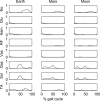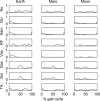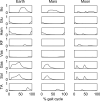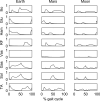Predictive simulation of gait at low gravity reveals skipping as the preferred locomotion strategy
- PMID: 22365845
- PMCID: PMC3327825
- DOI: 10.1016/j.jbiomech.2012.01.029
Predictive simulation of gait at low gravity reveals skipping as the preferred locomotion strategy
Abstract
The investigation of gait strategies at low gravity environments gained momentum recently as manned missions to the Moon and to Mars are reconsidered. Although reports by astronauts of the Apollo missions indicate alternative gait strategies might be favored on the Moon, computational simulations and experimental investigations have been almost exclusively limited to the study of either walking or running, the locomotion modes preferred under Earth's gravity. In order to investigate the gait strategies likely to be favored at low gravity a series of predictive, computational simulations of gait are performed using a physiological model of the musculoskeletal system, without assuming any particular type of gait. A computationally efficient optimization strategy is utilized allowing for multiple simulations. The results reveal skipping as more efficient and less fatiguing than walking or running and suggest the existence of a walk-skip rather than a walk-run transition at low gravity. The results are expected to serve as a background to the design of experimental investigations of gait under simulated low gravity.
Copyright © 2012 Elsevier Ltd. All rights reserved.
Figures











References
-
- Ackermann M, van den Bogert AJ. Predictive simulation of gait at low gravity using direct collocation.. Proceedings of the North American Congress on Biomechanics; Ann Arbor, MI, United States. 2008. paper 78.
-
- Aerts P, de Clercq D. Deformation characteristics of the heel region of the shod foot during a simulated heel strike: The effect of varying midsole hardness. Journal of Sports Sciences. 1993;11:449–461. - PubMed
-
- Alexander RM. Estimates of speeds of dinosaurs. Nature. 1976;261:129–130.
-
- Alexander RM. Optimization and gaits in the locomotion of vertebrates. Physiological Reviews. 1989;69(4):1199–1227. - PubMed
Publication types
MeSH terms
Grants and funding
LinkOut - more resources
Full Text Sources
Miscellaneous

